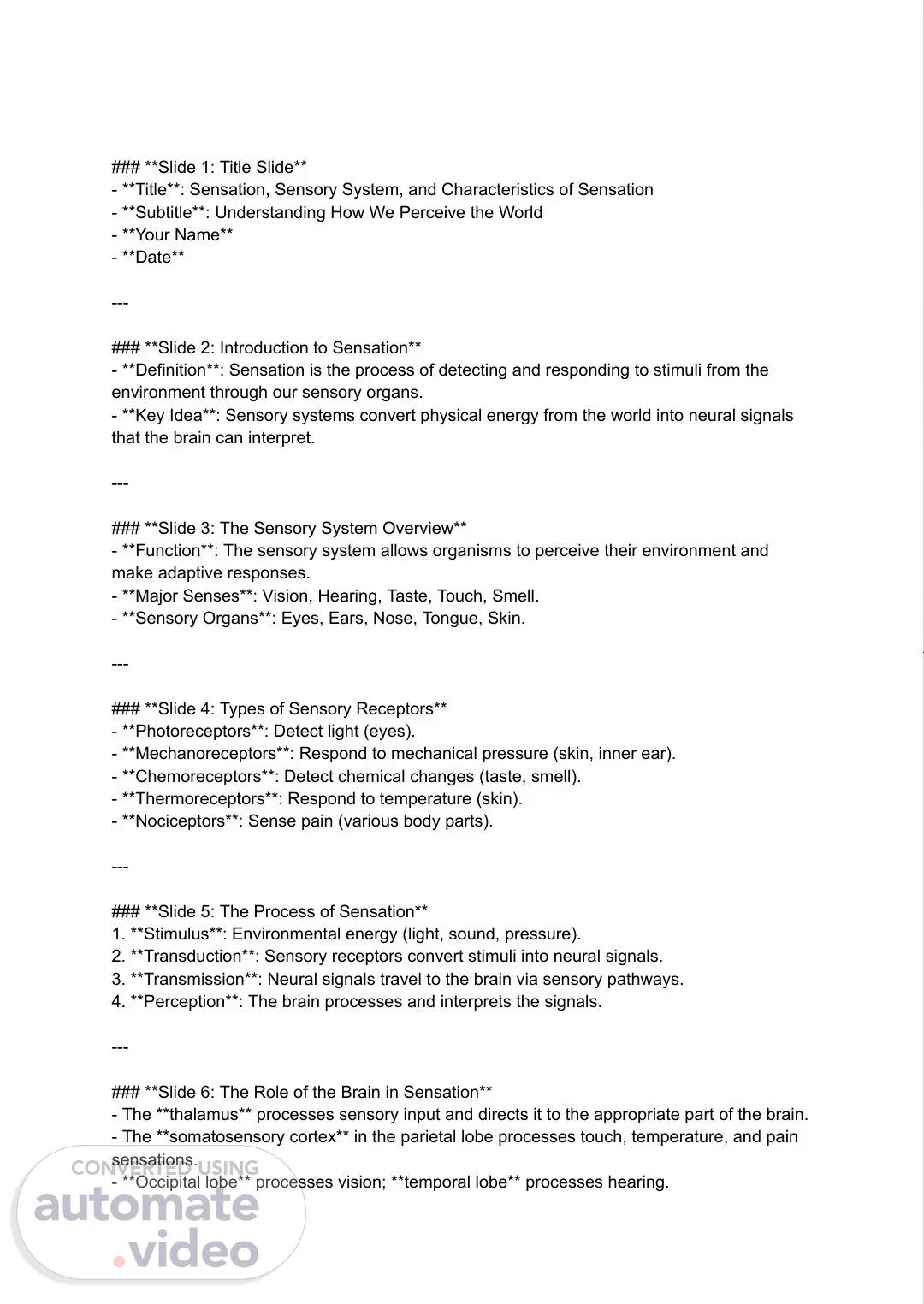Scene 1 (0s)
[Audio] ### **Slide 1: Title Slide** **Title**: Sensation, Sensory System, and Characteristics of Sensation **Subtitle**: Understanding How We Perceive the World **Your Name** **Date** --### **Slide 2: Introduction to Sensation** **Definition**: Sensation is the process of detecting and responding to stimuli from the environment through our sensory organs. **Key Idea**: Sensory systems convert physical energy from the world into neural signals that the brain can interpret. --### **Slide 3: The Sensory System Overview** **Function**: The sensory system allows organisms to perceive their environment and make adaptive responses. **Major Senses**: Vision, Hearing, Taste, Touch, Smell. **Sensory Organs**: Eyes, Ears, Nose, Tongue, Skin. --### **Slide 4: Types of Sensory Receptors** **Photoreceptors**: Detect light (eyes). **Mechanoreceptors**: Respond to mechanical pressure (skin, inner ear). **Chemoreceptors**: Detect chemical changes (taste, smell). **Thermoreceptors**: Respond to temperature (skin). **Nociceptors**: Sense pain (various body parts). --### **Slide 5: The Process of Sensation** 1. **Stimulus**: Environmental energy (light, sound, pressure). 2. **Transduction**: Sensory receptors convert stimuli into neural signals. 3. **Transmission**: Neural signals travel to the brain via sensory pathways. 4. **Perception**: The brain processes and interprets the signals. --### **Slide 6: The Role of the Brain in Sensation** The **thalamus** processes sensory input and directs it to the appropriate part of the brain. The **somatosensory cortex** in the parietal lobe processes touch, temperature, and pain sensations. **Occipital lobe** processes vision; **temporal lobe** processes hearing..
Scene 2 (2m 22s)
[Audio] --### **Slide 7: Characteristics of Sensation** **Intensity**: The strength of the stimulus. **Duration**: How long the sensation lasts. **Location**: Where the sensation occurs on the body. **Quality**: The specific nature of the sensation (for example, sweet, sour, hot, cold). --### **Slide 8: Sensory Adaptation** **Definition**: Sensory receptors become less sensitive to constant or unchanging stimuli. Example: Not noticing the feeling of clothes on your skin after a while. Helps focus on new or changing stimuli. --### **Slide 9: Absolute Threshold** **Definition**: The minimum intensity of a stimulus required for it to be detected. Example: The faintest sound you can hear in a quiet room. --### **Slide 10: Difference Threshold** **Definition**: The smallest detectable difference between two stimuli. **Weber’s Law**: The size of the just noticeable difference is a constant proportion of the original stimulus intensity. --### **Slide 11: Sensory Modality Differences** **Vision**: Perception of light intensity, color, and depth. **Hearing**: Detection of sound frequency, pitch, and volume. **Touch**: Perception of pressure, texture, and pain. **Taste**: Sensitivity to sweet, sour, salty, bitter, and umami. **Smell**: Sensitivity to various chemicals in the air. --### **Slide 12: The Role of Attention in Sensation** Sensory input can be influenced by **attention** and **focus**. **Selective attention**: Focusing on a specific stimulus while ignoring others. Example: Focusing on a conversation in a noisy room. --### **Slide 13: Common Sensory Disorders**.
Scene 3 (4m 33s)
[Audio] **Aphantasia**: Inability to visualize images mentally. **Prosopagnosia**: Difficulty in recognizing faces. **Phantom limb sensation**: Feeling pain or sensation in an amputated limb. **Sensory Processing Disorder**: Difficulty in processing sensory information. --### **Slide 14: Sensory Systems and Perception** **Perception against Sensation**: Perception is the interpretation of sensory input based on experience, context, and expectations. Example: Optical illusions highlight how perception can differ from reality. --### **Slide 15: Conclusion** Sensation is fundamental to how we experience the world, while the sensory system ensures we detect and interpret stimuli. Understanding the characteristics and mechanisms of sensation enriches our comprehension of human perception and the brain.
